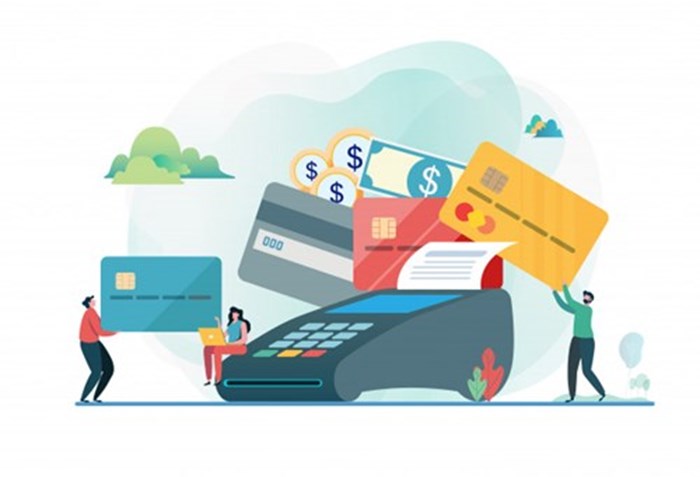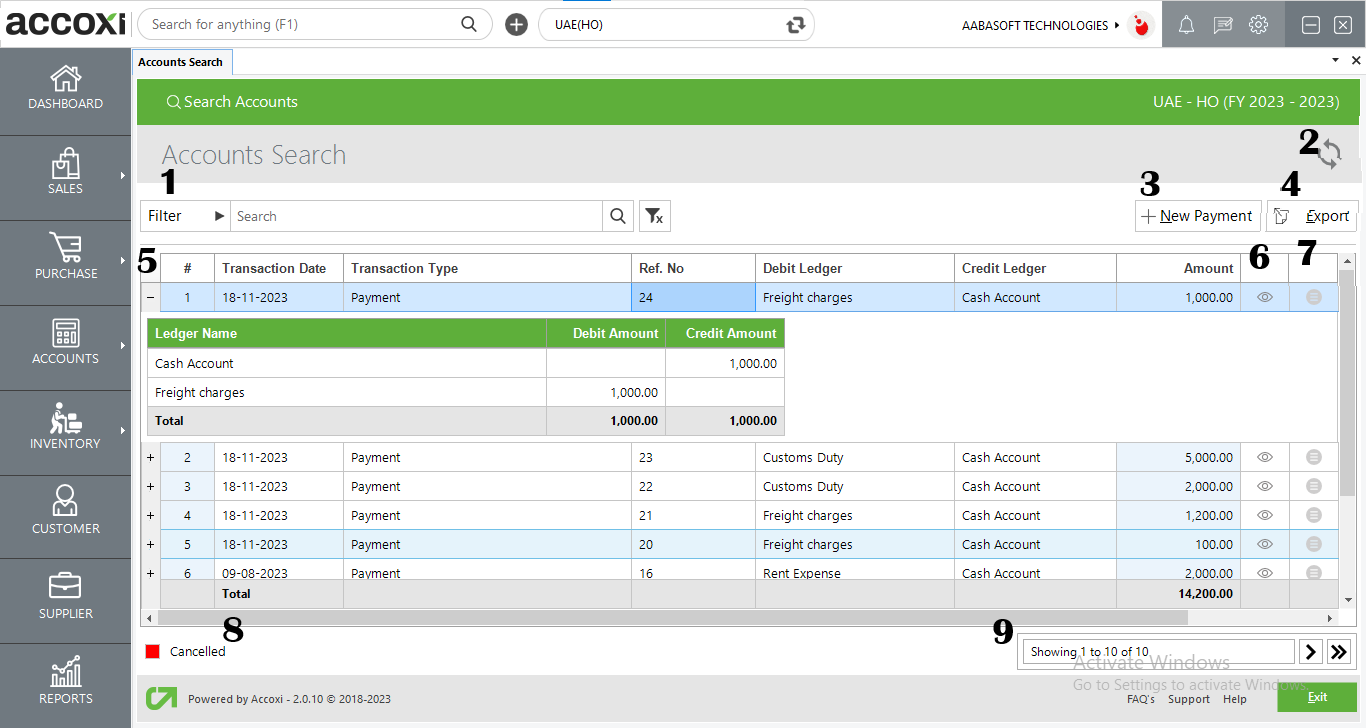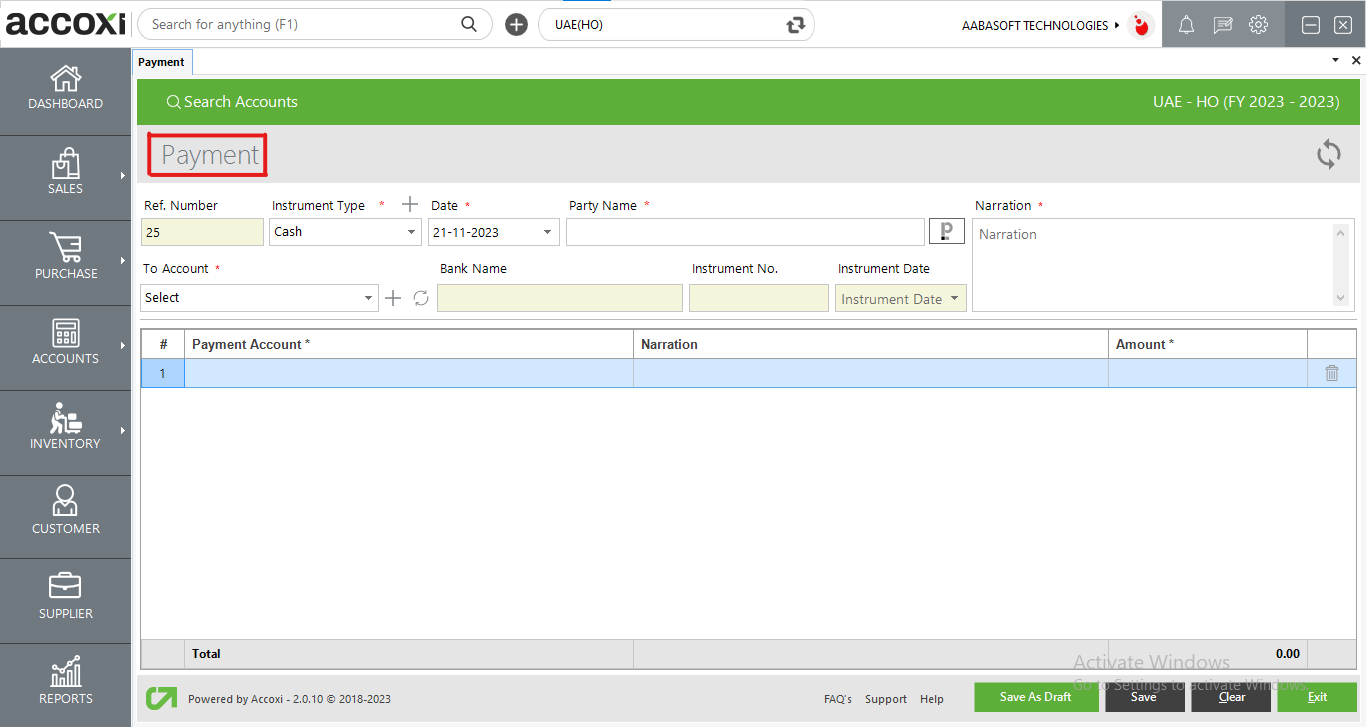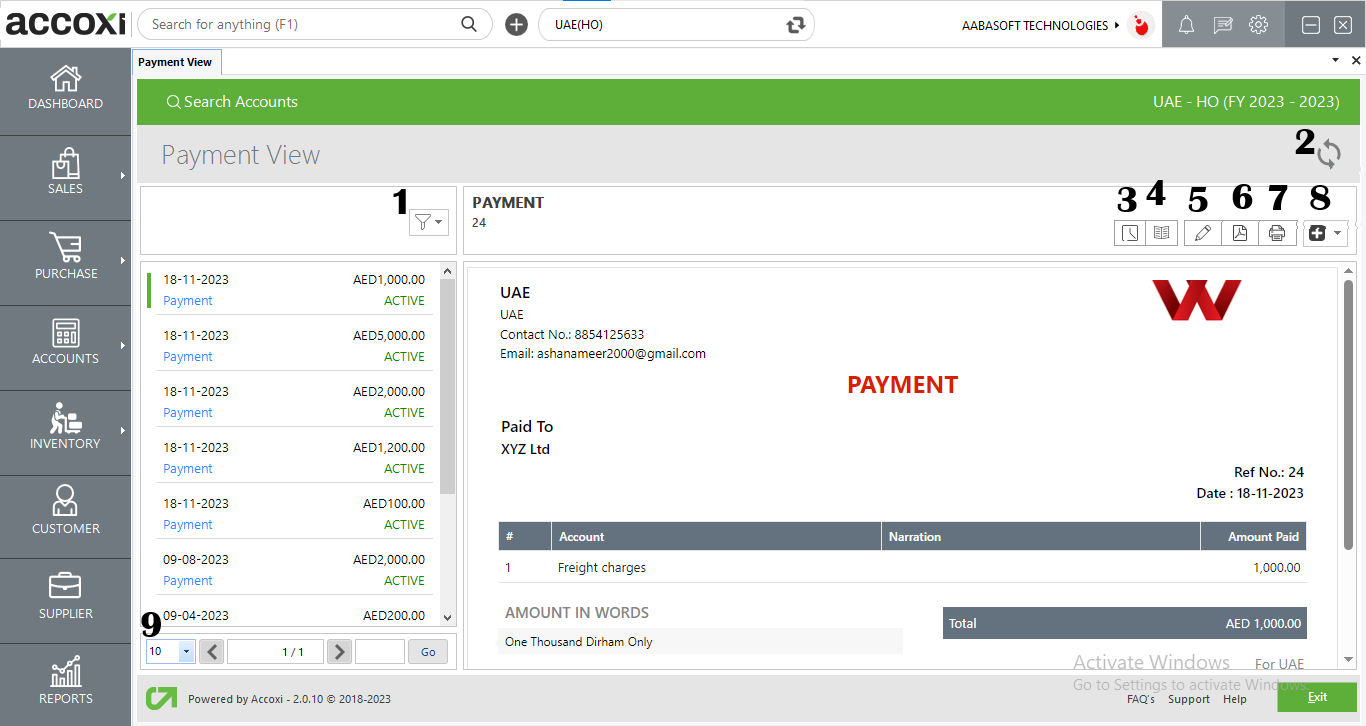
Look into the payments module of Accoxi

Payments in ACCOXI can be made in various forms, such as cash, check, wire transfer, credit or debit card, etc. This module is designed to handle small payments to the business. Larger amounts from suppliers are typically entered in the purchase module when payments are made.
Key Features:
Provides the ability to enter details of bank instruments used, ensuring a comprehensive record of the financial instruments associated with each payment transaction.


|
Field |
Description |
|
1. Filter |
The filtering of transactions can be carried out in two ways. Users have the option to either directly input the transaction type into the search bar near the filter option or use the filter dropdown.
Data can be filtered based on various criteria such as transaction type, ledger name, reference number, cancellation status, or date. When filtering by date, users need to input the starting date and the end date for the transactions. Transaction types available for filtering include sales invoices, purchase invoices, bills, debit notes, credit notes, and more. |
|
2. Refresh |
Click the refresh icon in the top-left corner to fetch the latest data if it's not displayed. |
|
3. +New Payment |
The "+New Payment" option allows users to initiate payment transactions and directs them to the payment creation window. |
|
4. Export |
To export the payment list to Excel format, locate the "Export" button at the top right corner near the "+New Payment" button. Click on the "Export" button, choose the desired file location, and then click on "Save." This process enables you to save the payment list data in Excel format for further analysis or record-keeping. |
|
5. Ledger View |
The payment details can be viewed in ledger format, showcasing the ledger accounts involved in the transaction. This ledger format provides a comprehensive overview of the financial aspects related to the payment. |
|
6. View |
The "View" menu allows the user to access and view the payment invoice that has already been created. This feature provides a convenient way to review and examine the details of the payment transaction. |
|
7. More Options |
This menu includes an edit function, allowing users to make changes to the created form. By clicking the edit option, the invoice form will appear on the screen, enabling users to modify the details as needed. |
|
8. Cancelled Payments |
Canceled payments are highlighted in red, making it easy for users to identify and distinguish them from active or completed transactions. |
|
9. Pagination Control |
This feature manages both page navigation and page size. Users can set the page size to 10, 20, 50, or 100. By entering the page number in the designated box and clicking on the "Go" button, the system swiftly navigates to the specified page. |
Steps to enter a new payment:

|
Field |
Description |
|
Ref. Number |
The reference number is automatically generated by ACCOXI for easy identification of payments. |
|
Instrument Type |
The user should select the type of instrument used for the payment. If the instrument is cash, the next columns like instrument number, date, and bank name will be blocked. |
|
Date |
The user can enter the date of the payment entry. By default, the current date will appear. |
|
Party Name |
The name of the recipient is entered here. |
|
Paperlez Integration |
This option enables users who have integrated Paperlez in ACCOXI to attach or associate documents with payment invoices. A tab will be opened, displaying all the documents uploaded in Paperlez. Users can choose the required documents to be attached to the invoice by associating the document. |
|
By Account |
Users should select the mode of an account, such as cash or through the bank. The + button can be used to add a new ledger account directly from this window, redirecting the user to the new ledger window. The refresh button helps the user refresh the by account drop-down list and view any changes made in the list. |
|
Bank Name |
Enter the name of the bank through which the payment is being made. |
|
Instrument No. |
Enter the instrument number if the payment is made through bank instruments other than cash. |
|
Instrument Date |
Enter the instrument date if the payment is made through bank instruments other than cash. |
|
Narration |
The narration for the transaction can be entered here. |
|
# |
The serial number of the table content. |
|
Account |
The user can enter the account of the expense from the drop-down menu. |
|
Narration |
The user can enter narration for the corresponding account. |
|
Amount |
The user can enter the payment amount. |
|
Delete |
This option can be used to delete the entries. |
|
Total |
The total payment amount is shown in this column. |
|
Amount In Words |
Shows the amount entered in words. |
|
Save As Draft |
Users can save the payments as drafts for further alterations and can later convert them into vouchers. |
|
Save |
By clicking "Save," the payments entered by the user will be saved. It will be visible in the Transaction menu, allowing users to track the payments using the reference number of the transaction. |
|
Clear |
To clear the data entered in the payment window, this option can be used. |
|
Refresh |
If your latest data is not displayed, click on the refresh icon at the top left corner of the page to fetch the new data. |
|
Exit |
To close the payment window without saving, users can click the exit button. |

|
Field |
Description |
|
1. Filter |
Users can filter out the payments based on active, cancelled, and drafts. |
|
2. Refresh |
If your latest data is not displayed, click on the refresh icon at the top left corner of the page to fetch the new data. |
|
3. History |
This menu helps the user obtain the history details of the payments. Options available in the history window include comments and history, showing all the edits and alterations of the payment. The date of changes made is displayed, allowing the user to enter any comments regarding the payments made. |
|
4. View journal |
It is the menu that shows the journal view of the transaction. The journal view displays both debit and credit aspects of the amount. |
|
5. Edit |
The Edit menu helps the user to edit or correct the details that are entered in the payment. |
|
6. Export To PDF |
If the user wants to convert the payment to PDF format, then the "Export to PDF" option is available. After clicking "Export to PDF," a Save As directory option will appear, and the user can choose the PDF file saving location. |
|
7. Print |
The Print menu helps the user to print the payment if required. After clicking the Print button, it will redirect to print options where the user can select the printer, number of copies to take, etc. |
|
8. More Features |
In the More Features option, users can cancel the payment. By clicking Cancel, a validation message will pop up. Then click "YES" to cancel the payment and click "NO" to cancel and close the option. |
|
9. Pagination Control |
It controls the page navigation and the page size. The page size can be set to 10, 20, 50, or 100. By entering the page number in the box and clicking on the Go button, it jumps to the said page. |